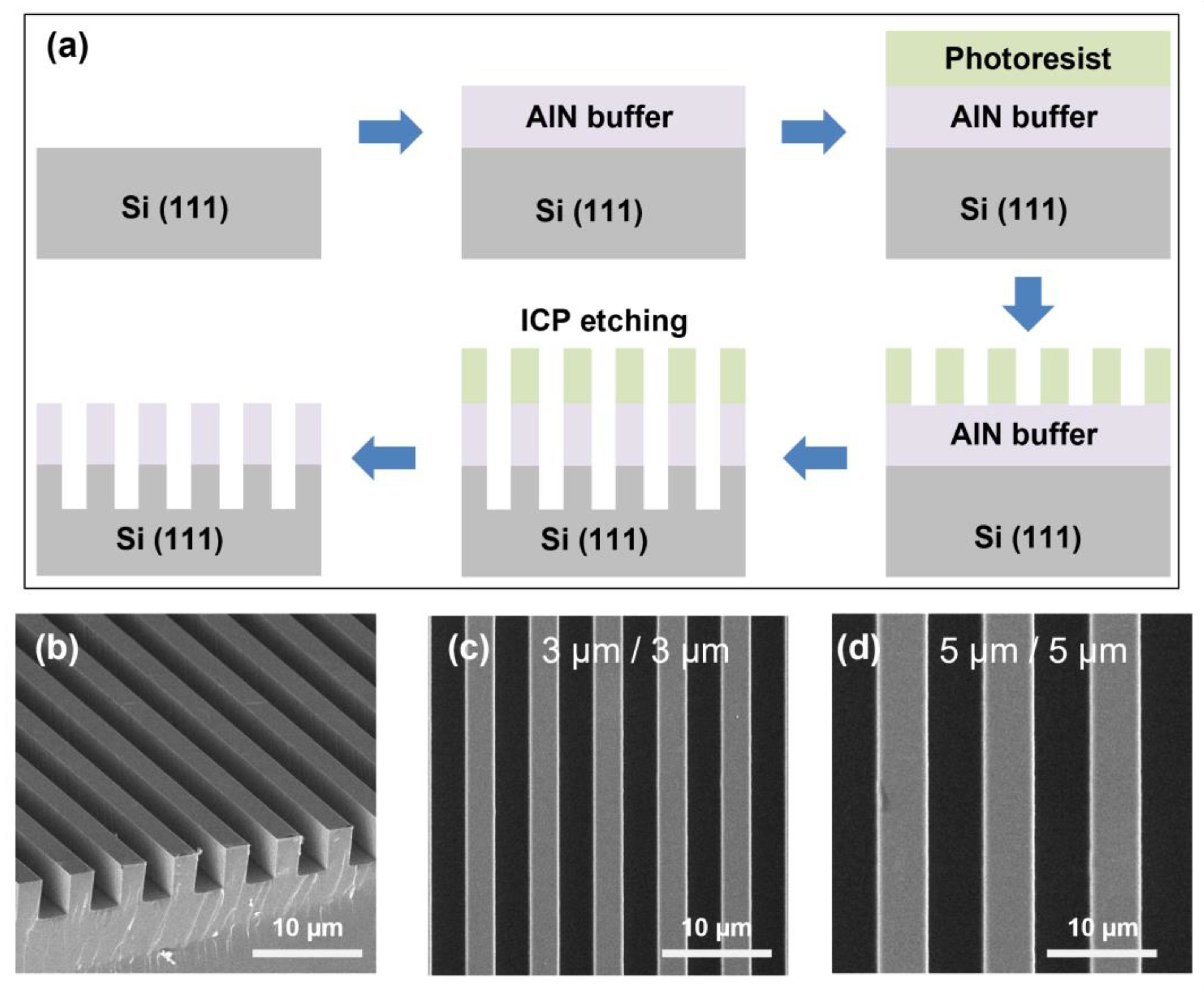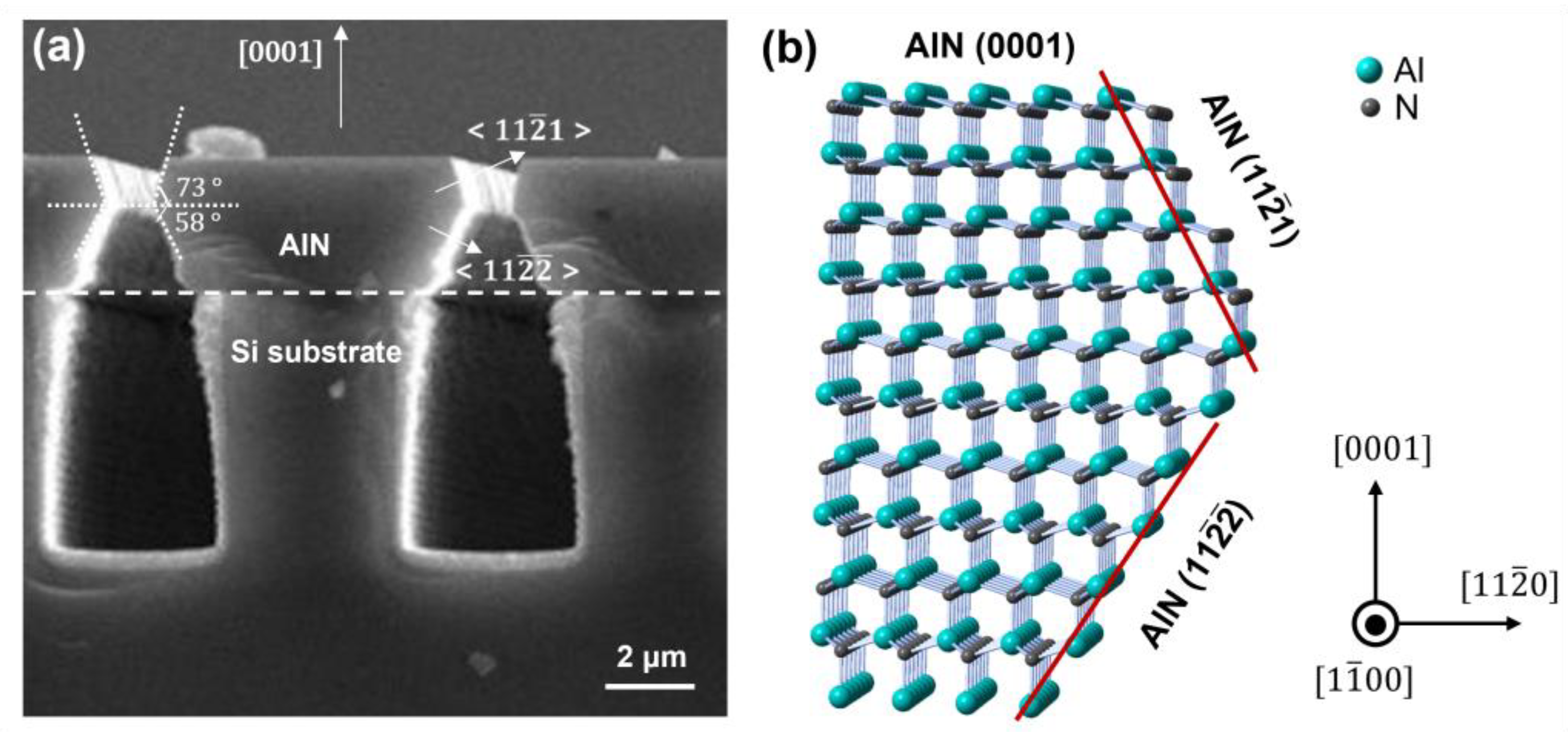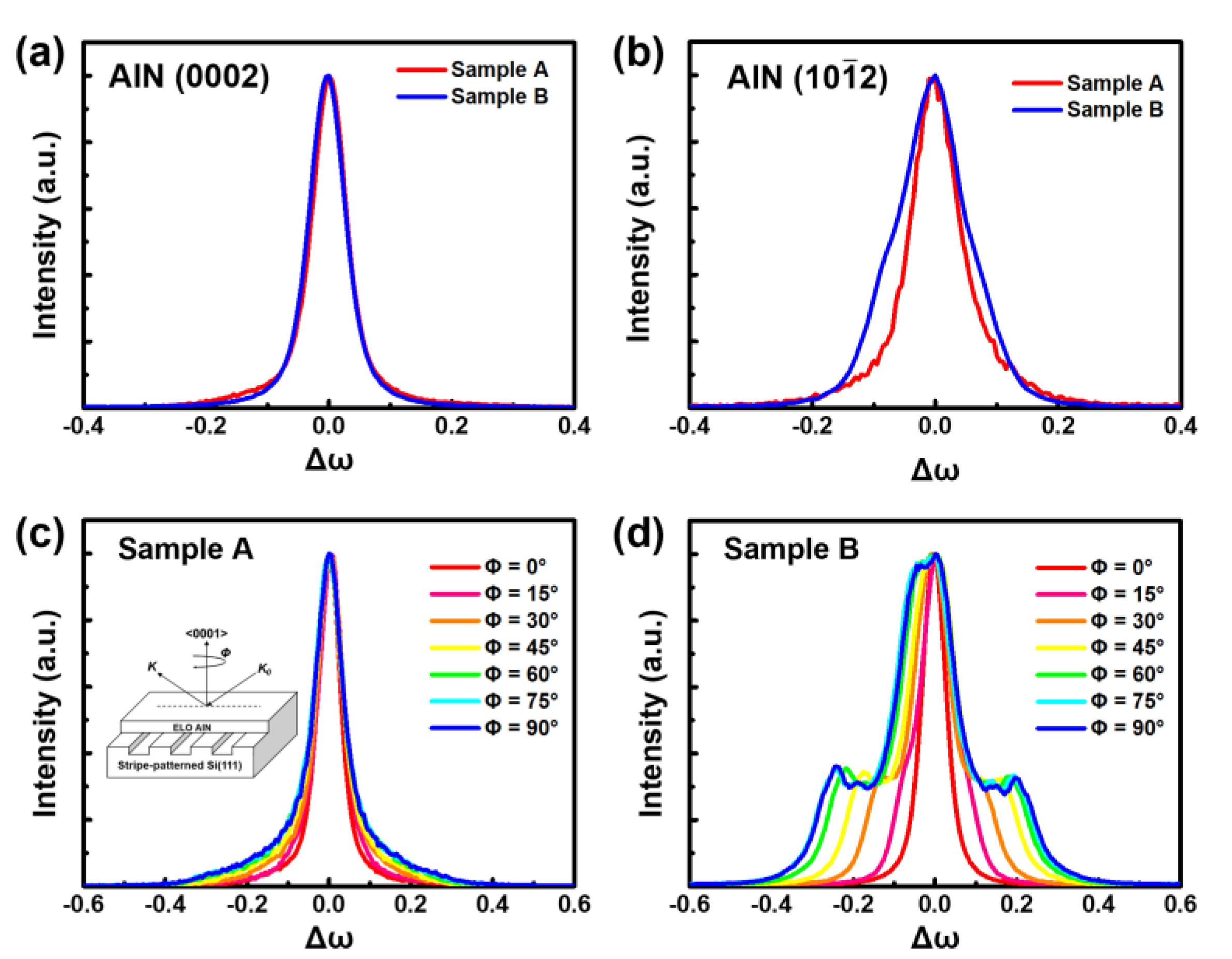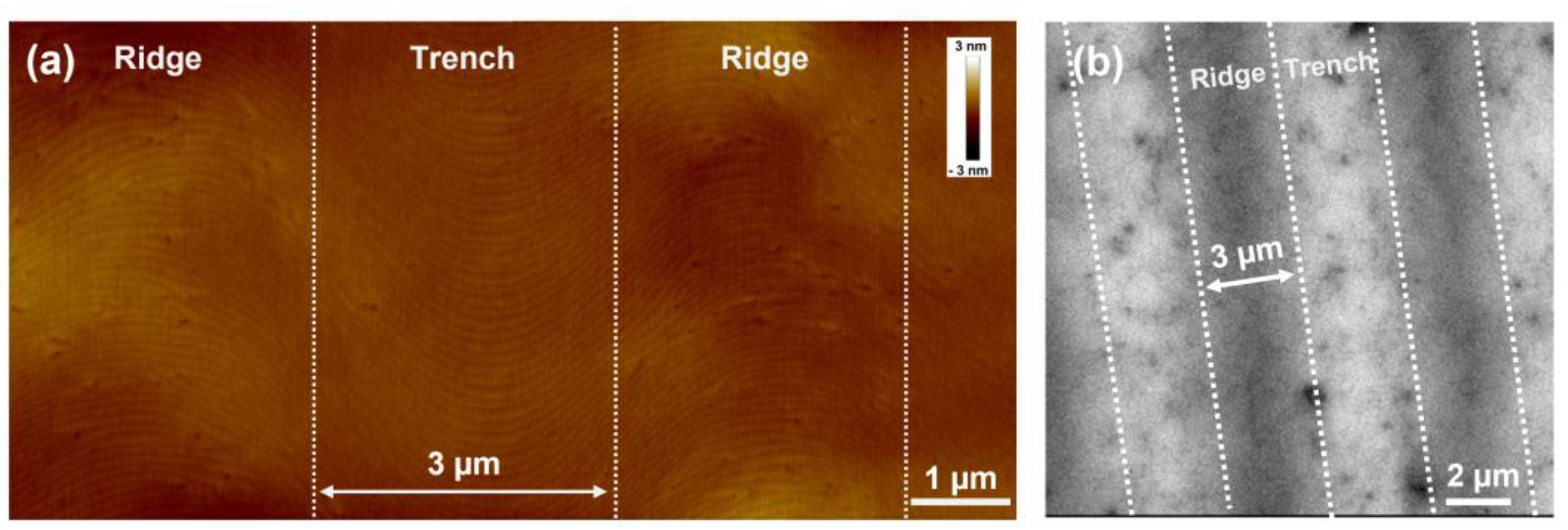High-Quality AlN Grown on Si(111) Substrate by Epitaxial Lateral Overgrowth
Abstract
1. Introduction
2. Materials and Methods
3. Results and Discussion
4. Conclusions
Author Contributions
Funding
Data Availability Statement
Acknowledgments
Conflicts of Interest
References
- Kneissl, M.; Seong, T.-Y.; Han, J.; Amano, H. The emergence and prospects of deep-ultraviolet light-emitting diode technologies. Nat. Photonics 2019, 13, 233. [Google Scholar] [CrossRef]
- Liu, Y.; Cai, Y.; Zhang, Y.; Tovstopyat, A.; Liu, S.; Sun, C. Materials, Design, and Characteristics of Bulk Acoustic Wave Resonator: A Review. Micromachines 2020, 11, 630. [Google Scholar] [CrossRef] [PubMed]
- Dai, Y.; Li, S.; Sun, Q.; Peng, Q.; Gui, C.; Zhou, Y.; Liu, S. Properties of AlN film grown on Si(111). J. Cryst. Growth 2016, 435, 76. [Google Scholar] [CrossRef]
- Zhao, W.; Asadi, M.J.; Li, L.; Chaudhuri, R.; Nomoto, K.; Xing, H.G.; Hwang, J.C.M.; Jena, D. X-band epi-BAW resonators. J. Appl. Phys. 2022, 132, 024503. [Google Scholar] [CrossRef]
- Zhang, Y.; Long, H.; Zhang, J.; Tan, B.; Chen, Q.; Zhang, S.; Shan, M.; Zheng, Z.; Dai, J.; Chen, C. Fast growth of high quality AlN films on sapphire using a dislocation filtering layer for ultraviolet light-emitting diodes. Crystengcomm 2019, 21, 4072. [Google Scholar] [CrossRef]
- Ezubchenko, I.S.; Chernykh, M.Y.; Mayboroda, I.O.; Trun’kin, I.N.; Chernykh, I.A.; Zanaveskin, M.L. High-Quality AlN Layers Grown on Si(111) Substrates by Metalorganic Chemical Vapor Deposition. Crystallogr. Rep. 2020, 65, 122. [Google Scholar] [CrossRef]
- Huang, L.; Li, Y.; Wang, W.; Li, X.; Zheng, Y.; Wang, H.; Zhang, Z.; Li, G. Growth of high-quality AlN epitaxial film by optimizing the Si substrate surface. Appl. Surf. Sci. 2018, 435, 163. [Google Scholar] [CrossRef]
- Tao, T.; Zhang, R.; Zhi, T.; Liu, B.; Lei, J.; Dai, J.; Xie, Z.; Zhou, Y.; Chen, D.; Lu, H. Observation and Modeling of Leakage Current in AlGaN Ultraviolet Light Emitting Diodes. IEEE Photonics Technol. Lett. 2019, 31, 1697. [Google Scholar] [CrossRef]
- Huang, Y.; Liu, J.; Sun, X.; Zhan, X.; Sun, Q.; Gao, H.; Feng, M.; Zhou, Y.; Ikeda, M.; Yang, H. Crack-free high quality 2 μm-thick Al0.5Ga0.5N grown on a Si substrate with a superlattice transition layer. Crystengcomm 2020, 22, 1160. [Google Scholar] [CrossRef]
- Li, Z.; Liu, L.; Huang, Y.; Sun, Q.; Feng, M.; Zhou, Y.; Zhao, H.; Yang, H. High-power AlGaN-based near-ultraviolet light-emitting diodes grown on Si(111). Appl. Phys. Express 2017, 10, 072101. [Google Scholar] [CrossRef]
- SaifAddin, B.K.; Almogbel, A.; Zollner, C.J.; Foronda, H.; Alyamani, A.; Albadri, A.; Iza, M.; Nakamura, S.; DenBaars, S.P.; Speck, J.S. Fabrication technology for high light-extraction ultraviolet thin-film flip-chip (UV TFFC) LEDs grown on SiC. Semicond. Sci. Technol. 2019, 34, 035007. [Google Scholar] [CrossRef]
- Takeuchi, M.; Maegawa, T.; Shimizu, H.; Ooishi, S.; Ohtsuka, T.; Aoyagi, Y. AlN/AlGaN short-period superlattice sacrificial layers in laser lift-off for vertical-type AlGaN-based deep ultraviolet light emitting diodes. Appl. Phys. Lett. 2009, 94, 061117. [Google Scholar] [CrossRef]
- Cho, H.K.; Krüger, O.; Külberg, A.; Rass, J.; Zeimer, U.; Kolbe, T.; Knauer, A.; Einfeldt, S.; Weyers, M.; Kneissl, M. Chip design for thin-film deep ultraviolet LEDs fabricated by laser lift-off of the sapphire substrate. Semicond. Sci. Technol. 2017, 32, 12LT01. [Google Scholar] [CrossRef]
- Sun, Y.; Zhou, K.; Feng, M.; Li, Z.; Zhou, Y.; Sun, Q.; Liu, J.; Zhang, L.; Li, D.; Sun, X.; et al. Room-temperature continuous-wave electrically pumped InGaN/GaN quantum well blue laser diode directly grown on Si. Light Sci. Appl. 2018, 7, 13. [Google Scholar] [CrossRef]
- Feng, M.; Wang, J.; Zhou, R.; Sun, Q.; Gao, H.; Zhou, Y.; Liu, J.; Huang, Y.; Zhang, S.; Ikeda, M.; et al. On-Chip Integration of GaN-Based Laser, Modulator, and Photodetector Grown on Si. IEEE J. Sel. Top. Quantum Electron. 2018, 24, 1. [Google Scholar] [CrossRef]
- Liu, J.; Huang, Y.; Sun, X.; Zhan, X.; Sun, Q.; Gao, H.; Feng, M.; Zhou, Y.; Ikeda, M.; Yang, H. Wafer-scale crack-free 10 µm-thick GaN with a dislocation density of 5.8 × 107 cm−2 grown on Si. J. Phys. D 2019, 52, 425102. [Google Scholar] [CrossRef]
- Sun, Q.; Yan, W.; Feng, M.; Li, Z.; Feng, B.; Zhao, H.; Yang, H. GaN-on-Si blue/white LEDs: Epitaxy, chip, and package. J. Semicond. 2016, 37, 044006. [Google Scholar] [CrossRef]
- Sun, Y.; Zhou, K.; Sun, Q.; Liu, J.; Feng, M.; Li, Z.; Zhou, Y.; Zhang, L.; Li, D.; Zhang, S.; et al. Room-temperature continuous-wave electrically injected InGaN-based laser directly grown on Si. Nat. Photonics 2016, 10, 595. [Google Scholar] [CrossRef]
- Zhang, Z.-Z.; Yang, J.; Zhao, D.-G.; Liang, F.; Chen, P.; Liu, Z.-S. Influence of the lattice parameter of the AlN buffer layer on the stress state of GaN film grown on (111) Si. Chin. Phys. B 2023, 32, 028101. [Google Scholar] [CrossRef]
- Bardhan, A.; Raghavan, S. Growth design for high quality AlxGa(1−x)N layer with high AlN-fraction on Si (1 1 1) substrate by MOCVD. J. Cryst. Growth 2022, 578, 126418. [Google Scholar] [CrossRef]
- Lange, A.P.; Mahajan, S. Influence of trimethylaluminum predoses on the growth morphology, film-substrate interface, and microstructure of MOCVD-grown AlN on (1 1 1)Si. J. Cryst. Growth 2019, 511, 106. [Google Scholar] [CrossRef]
- Radtke, G.; Couillard, M.; Botton, G.A.; Zhu, D.; Humphreys, C.J. Structure and chemistry of the Si(111)/AlN interface. Appl. Phys. Lett. 2012, 100, 011910. [Google Scholar] [CrossRef]
- Mino, T.; Hirayama, H.; Takano, T.; Tsubaki, K.; Sugiyama, M. Realization of 256–278 nm AlGaN-Based Deep-Ultraviolet Light-Emitting Diodes on Si Substrates Using Epitaxial Lateral Overgrowth AlN Templates. Appl. Phys. Express 2011, 4, 092104. [Google Scholar] [CrossRef]
- Cho, C.-Y.; Zhang, Y.; Cicek, E.; Rahnema, B.; Bai, Y.; McClintock, R.; Razeghi, M. Surface plasmon enhanced light emission from AlGaN-based ultraviolet light-emitting diodes grown on Si(111). Appl. Phys. Lett. 2013, 102, 211110. [Google Scholar] [CrossRef]
- Cicek, E.; McClintock, R.; Cho, C.Y.; Rahnema, B.; Razeghi, M. AlxGa1−xN-based solar-blind ultraviolet photodetector based on lateral epitaxial overgrowth of AlN on Si substrate. Appl. Phys. Lett. 2013, 103, 181113. [Google Scholar] [CrossRef]
- Zhang, Y.; Gautier, S.; Cho, C.-Y.; Cicek, E.; Vashaei, Z.; McClintock, R.; Bayram, C.; Bai, Y.; Razeghi, M. Near milliwatt power AlGaN-based ultraviolet light emitting diodes based on lateral epitaxial overgrowth of AlN on Si(111). Appl. Phys. Lett. 2013, 102, 011106. [Google Scholar] [CrossRef]
- Tran, B.T.; Hirayama, H.; Maeda, N.; Jo, M.; Toyoda, S.; Kamata, N. Direct Growth and Controlled Coalescence of Thick AlN Template on Micro-circle Patterned Si Substrate. Sci. Rep. 2015, 5, 14734. [Google Scholar] [CrossRef]
- Demir, İ.; Robin, Y.; McClintock, R.; Elagoz, S.; Zekentes, K.; Razeghi, M. Direct growth of thick AlN layers on nanopatterned Si substrates by cantilever epitaxy. Phys. Status Solidi (A) 2017, 214, 1600363. [Google Scholar] [CrossRef]
- Tran, B.T.; Hirayama, H. Growth and Fabrication of High External Quantum Efficiency AlGaN-Based Deep Ultraviolet Light-Emitting Diode Grown on Pattern Si Substrate. Sci. Rep. 2017, 7, 12176. [Google Scholar] [CrossRef] [PubMed]
- Robin, Y.; Ding, K.; Demir, I.; McClintock, R.; Elagoz, S.; Razeghi, M. High brightness ultraviolet light-emitting diodes grown on patterned silicon substrate. Mater. Sci. Semicond. Process. 2019, 90, 87. [Google Scholar] [CrossRef]
- Shen, J.; Yang, X.; Liu, D.; Cai, Z.; Wei, L.; Xie, N.; Xu, F.; Tang, N.; Wang, X.; Ge, W.; et al. High quality AlN film grown on a nano-concave-circle patterned Si substrate with an AlN seed layer. Appl. Phys. Lett. 2020, 117, 022103. [Google Scholar] [CrossRef]
- Roskowski, A.; Preble, E.; Einfeldt, S.; Miraglia, P.; Davis, R. Maskless pendeo-epitaxial growth of GaN films. J. Electron. Mater. 2002, 31, 421. [Google Scholar] [CrossRef]
- Hirayama, H.; Fujikawa, S.; Norimatsu, J.; Takano, T.; Tsubaki, K.; Kamata, N. Fabrication of a low threading dislocation density ELO-AlN template for application to deep-UV LEDs. Phys. Status Solidi (C) 2009, 6, S356–S359. [Google Scholar] [CrossRef]
- Chen, X.; Yan, J.; Zhang, Y.; Tian, Y.; Guo, Y.; Zhang, S.; Wei, T.; Wang, J.; Li, J. Improved Crystalline Quality of AlN by Epitaxial Lateral Overgrowth Using Two-Phase Growth Method for Deep-Ultraviolet Stimulated Emission. IEEE Photonics J. 2016, 8, 2300211. [Google Scholar] [CrossRef]
- Founta, S.; Bougerol, C.; Mariette, H.; Daudin, B.; Vennéguès, P. Anisotropic morphology of nonpolar a-plane GaN quantum dots and quantum wells. J. Appl. Phys. 2007, 102, 2300211. [Google Scholar] [CrossRef]
- Sun, Q.; Yerino, C.D.; Leung, B.; Han, J.; Coltrin, M.E. Understanding and controlling heteroepitaxy with the kinetic Wulff plot: A case study with GaN. J. Appl. Phys. 2011, 110, 053517. [Google Scholar] [CrossRef]
- Lee, S.R.; West, A.M.; Allerman, A.A.; Waldrip, K.E.; Follstaedt, D.M.; Provencio, P.P.; Koleske, D.D.; Abernathy, C.R. Effect of threading dislocations on the Bragg peakwidths of GaN, AlGaN, and AlN heterolayers. Appl. Phys. Lett. 2005, 86, 241904. [Google Scholar] [CrossRef]
- Hagedorn, S.; Knauer, A.; Mogilatenko, A.; Richter, E.; Weyers, M. AlN growth on nano-patterned sapphire: A route for cost efficient pseudo substrates for deep UV LEDs. Phys. Status Solidi (A) 2016, 213, 3178. [Google Scholar] [CrossRef]
- Mogilatenko, A.; Küller, V.; Knauer, A.; Jeschke, J.; Zeimer, U.; Weyers, M.; Tränkle, G. Defect analysis in AlGaN layers on AlN templates obtained by epitaxial lateral overgrowth. J. Cryst. Growth 2014, 402, 222. [Google Scholar] [CrossRef]
- Pantha, B.N.; Dahal, R.; Nakarmi, M.L.; Nepal, N.; Li, J.; Lin, J.Y.; Jiang, H.X.; Paduano, Q.S.; Weyburne, D. Correlation between optoelectronic and structural properties and epilayer thickness of AlN. Appl. Phys. Lett. 2007, 90, 241101. [Google Scholar] [CrossRef]
- Yu, N.S.; Zhu, X.L.; Peng, M.Z.; Zhou, J.M. Wing tilt investigations on GaN epilayer grown on maskless grooved sapphire by MOCVD. J. Mater. Sci. 2009, 45, 1503. [Google Scholar] [CrossRef]
- Barabash, R.I.; Roder, C.; Ice, G.E.; Einfeldt, S.; Budai, J.D.; Barabash, O.M.; Figge, S.; Hommel, D. Spatially resolved distribution of dislocations and crystallographic tilts in GaN layers grown on Si(111) substrates by maskless cantilever epitaxy. J. Appl. Phys. 2006, 100, 053103. [Google Scholar] [CrossRef]
- Benyoucef, M.; Kuball, M.; Beaumont, B.; Gibart, P. Raman mapping, photoluminescence investigations, and finite element analysis of epitaxial lateral overgrown GaN on silicon substrates. Appl. Phys. Lett. 2002, 80, 2275. [Google Scholar] [CrossRef]







| Group | Substrate Pattern | Thickness (μm) | AlN (0002) (Arcsec) | AlN (10) (Arcsec) |
|---|---|---|---|---|
| Mino et al. [23] | micro-stripe | 4.3 | 780 | 980 |
| Zhang et.al [26] | micro-stripe | 7 | 920 | 780 |
| Tran et.al [27] | micro-circle | 8 | 620 | 1141 |
| Demir et.al [28] | nano-stripe | 2 | 710 | 930 |
| Robin et.al [30] | micro-stripe | 6 | 553 | 768 |
| Shen et.al [31] | nano-circle | 2 | 409 | 677 |
| This work | micro-stripe | 6 | 260 | 374 |
Disclaimer/Publisher’s Note: The statements, opinions and data contained in all publications are solely those of the individual author(s) and contributor(s) and not of MDPI and/or the editor(s). MDPI and/or the editor(s) disclaim responsibility for any injury to people or property resulting from any ideas, methods, instructions or products referred to in the content. |
© 2023 by the authors. Licensee MDPI, Basel, Switzerland. This article is an open access article distributed under the terms and conditions of the Creative Commons Attribution (CC BY) license (https://creativecommons.org/licenses/by/4.0/).
Share and Cite
Huang, Y.; Liu, J.; Sun, X.; Zhan, X.; Sun, Q.; Gao, H.; Feng, M.; Zhou, Y.; Yang, H. High-Quality AlN Grown on Si(111) Substrate by Epitaxial Lateral Overgrowth. Crystals 2023, 13, 454. https://doi.org/10.3390/cryst13030454
Huang Y, Liu J, Sun X, Zhan X, Sun Q, Gao H, Feng M, Zhou Y, Yang H. High-Quality AlN Grown on Si(111) Substrate by Epitaxial Lateral Overgrowth. Crystals. 2023; 13(3):454. https://doi.org/10.3390/cryst13030454
Chicago/Turabian StyleHuang, Yingnan, Jianxun Liu, Xiujian Sun, Xiaoning Zhan, Qian Sun, Hongwei Gao, Meixin Feng, Yu Zhou, and Hui Yang. 2023. "High-Quality AlN Grown on Si(111) Substrate by Epitaxial Lateral Overgrowth" Crystals 13, no. 3: 454. https://doi.org/10.3390/cryst13030454
APA StyleHuang, Y., Liu, J., Sun, X., Zhan, X., Sun, Q., Gao, H., Feng, M., Zhou, Y., & Yang, H. (2023). High-Quality AlN Grown on Si(111) Substrate by Epitaxial Lateral Overgrowth. Crystals, 13(3), 454. https://doi.org/10.3390/cryst13030454







